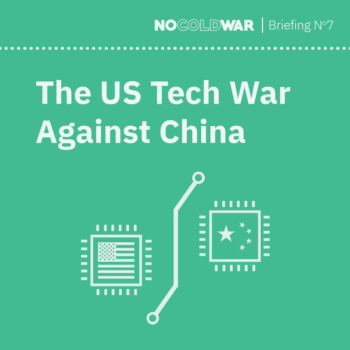Dear friends,
Greetings from the desk of Tricontinental: Institute for Social Research.
On 7 October 2022, the United States government implemented export controls in an effort to hinder the development of China’s semiconductor industry. An expert on the subject told the Financial Times, ‘The whole point of the policy is to kneecap China’s AI [Artificial Intelligence] and HPC [High Performance Computing] efforts’. The next day, China’s Foreign Ministry spokesperson Mao Ning said:
In order to maintain its sci-tech hegemony, the U.S. has been abusing export control measures to wantonly block and hobble Chinese enterprises. Such practice runs counter to the principle of fair competition and international trade rules. It will not only harm Chinese companies’ legitimate rights and interests but also hurt the interests of U.S. companies. It will hinder international sci-tech exchange and trade cooperation and deal a blow to global industrial and supply chains and world economic recovery. By politicising tech and trade issues and using them as a tool and weapon, the U.S. cannot hold back China’s development but will only hurt and isolate itself when its action backfires.
 As part of Tricontinental: Institute for Social Research’s collaboration with No Cold War, we studied the implications of these export controls with a focus on semiconductors. Briefing no. 7 teaches us about the vitality of semiconductors and why their use in the New Cold War will not bear the fruits anticipated by Washington.
As part of Tricontinental: Institute for Social Research’s collaboration with No Cold War, we studied the implications of these export controls with a focus on semiconductors. Briefing no. 7 teaches us about the vitality of semiconductors and why their use in the New Cold War will not bear the fruits anticipated by Washington.
On 8 April, Chairman of the U.S. House Foreign Affairs Committee Michael McCaul was asked to explain ‘why Americans… should be willing to spill American blood and treasure to defend Taiwan’. His answer was telling: ‘TSMC [Taiwan Semiconductor Manufacturing Company] manufactures 90% of the global supply of advanced semiconductor chips’. The interviewer noted that McCaul’s reasoning ‘sounds like the case that [was] made in the 60s, 70s, and 80s of why America was spending so much money and military resources in the Middle East [when] oil was so important for the economy’ and then asked whether semiconductor chips are ‘the 21st century version’ of oil—that is, a key driver of U.S. foreign policy towards China.
Semiconductor chips are the building blocks of the world’s most advanced technologies (such as artificial intelligence, 5G telecommunications, and supercomputing) as well as all modern electronics. Without them, the computers, phones, cars, and devices that are essential to our everyday lives would cease to function. They are typically produced by using ultraviolet light to etch microscopic circuit patterns onto thin layers of silicon, packing billions of electrical switches called transistors onto a single fingernail-sized wafer. This technology advances through a relentless process of miniaturisation: the smaller the distance between transistors, the greater the density of transistors that can be packed onto a chip and the more computing power that can be embedded in each chip and in each facet of modern life. Today, the most advanced chips are produced with a three-nanometre (nm) process (for reference, a sheet of paper is roughly 100,000-nm thick).
The Semiconductor Supply Chain

Charles Sheeler (United States), Classic Landscape, 1931.
The commercial semiconductor industry was developed in Silicon Valley, California in the late 1950s, dominated by the United States in all aspects, from research and design to manufacture and sales. From the outset, this industry held geopolitical significance, with early manufacturers selling upwards of 95% of their chips to the Pentagon or the aerospace sector. Over the subsequent decades, the U.S. selectively offshored most of its chip manufacturing to its East Asian allies, first to Japan, then to South Korea and Taiwan. This allowed the U.S. to reduce its capital and labour costs and stimulate the industrial development of its allies while continuing to dominate the supply chain.
Today, U.S. firms maintain a commanding presence in chip design (e.g., Intel, AMD, Broadcom, Qualcomm, and NVIDIA) and fabrication equipment (e.g., Applied Materials, Lam Research, and KLA). Taiwan’s TSMC is the world’s largest semiconductor manufacturer or foundry, accounting for an overwhelming 56% share of the global market and over 90% of advanced chip manufacturing in 2022, followed by South Korea’s Samsung, which holds a 15% share of the global market. In addition, the Dutch firm ASML is a critical player, holding a monopoly on extreme ultraviolet (EUV) lithography machines needed to produce the most advanced chips below 7-nm.

Giorgio de Chirico (Italy), Ettore e Andromaca (‘Hector and Andromache’), 1955—56.
The largest part of the semiconductor supply chain that lies outside of the control of the U.S. and its allies is in China, which has developed into the world’s electronics manufacturing hub and a major technological power over the past four decades. China’s share of global chip manufacturing capacity has risen from zero in 1990 to roughly 15% in 2020. Yet, despite its sizeable developmental advances, China’s chip production capabilities still lag behind, relying on imports for the most advanced chips (in 2020, China imported $378 billion worth of semiconductors, 18% of its total imports). Meanwhile, China’s largest semiconductor manufacturer, SMIC, only has a 5% share of the global market, paling in comparison to TSMC.
The U.S. Campaign against China
In recent years, the U.S. has been waging an aggressive campaign to arrest China’s technological development, which it views as a serious threat to its dominance. In the words of U.S. National Security Adviser Jake Sullivan, Washington’s goal is to ‘maintain as large of a lead as possible’. To this end, the U.S. has identified China’s semiconductor production capabilities as an important weakness and is trying to block the country’s access to advanced chips and chip-making technology. Under the Trump and Biden administrations, the U.S. has placed hundreds of Chinese companies on trade and investment blacklists, including the country’s leading semiconductor manufacturer SMIC and tech giant Huawei. These restrictions have banned any company in the world that uses U.S. products—effectively every chip designer and manufacturer—from doing business with Chinese tech firms.
The U.S. has also pressured governments and firms around the world to impose similar restrictions. Since 2018, Australia, Canada, New Zealand, and the United Kingdom have joined the U.S. in banning Huawei from their 5G telecommunications networks while a number of European countries have implemented partial bans or restrictions. Importantly, in 2019, after more than a year of intense U.S. lobbying, the Dutch government blocked the key firm ASML, which builds and supplies the most advanced chip-making machinery to the semiconductor industry, from exporting its equipment to China.

Lu Yang (China), Delusional World—Bardo #1, 2021.
These policies do not only target firms; they also have a direct impact on an individual level. In October 2022, the Biden administration restricted ‘US persons’—including citizens, residents, and green-card holders—from working for Chinese chip firms, forcing many to choose between their immigration status and their jobs. The Centre for Strategic and International Studies, a leading Washington, DC think tank, characterised U.S. policy as ‘actively strangling large segments of the Chinese technology industry—strangling with an intent to kill’ (our emphasis).
Alongside its containment measures against China, the U.S. has ramped up efforts to boost its domestic chip-making capacity. The CHIPS and Science Act, signed into law in August 2022, provides $280 billion in funding to boost the domestic U.S. semiconductor industry and reshore production from East Asia. Washington views Taiwan’s role as the manufacturing hub of the semiconductor industry as a strategic vulnerability given its proximity to mainland China and is inducing TSMC to relocate production to Phoenix, Arizona. This pressure, in turn, is generating its own frictions in the U.S.-Taiwan relationship.
However, U.S. efforts are not infallible. Although China has suffered serious setbacks, it has intensified efforts to promote its domestic capacity, and there are signs of progress despite the obstacles imposed by the U.S. For example, in 2022, China’s SMIC reportedly achieved a significant technological breakthrough, making the leap from 14-nm to 7-nm semiconductor chips, which is on par with the global leaders Intel, TSMC, and Samsung.
A Matter of Global Importance

Skunder Boghossian (Ethiopia), The End of the Beginning, 1972—73.
It is important to note that the U.S. is not only targeting China in this conflict: Washington fears that China’s technological development will lead, through trade and investment, to the dispersal of advanced technologies more broadly throughout the world, namely, to states in the Global South that the U.S. sees as a threat. This would be a significant blow to the US’s power over these countries. In 2020, the U.S. Senate Foreign Relations Committee decried that China was facilitating ‘digital authoritarianism’ because it has ‘been willing to go into smaller, under-served markets’ and ‘offer more cost-effective equipment than Western companies’, pointing to countries under U.S. sanctions such as Venezuela and Zimbabwe as examples. To combat ties between Chinese tech firms and sanctioned countries, the U.S. has taken severe legal action, fining the Chinese corporation ZTE $1.2 billion in 2017 for violating U.S. sanctions against Iran and North Korea. The U.S. also collaborated with Canada to arrest Huawei executive Meng Wanzhou in 2018 on charges of circumventing U.S. sanctions against Iran.
Unsurprisingly, while the U.S. has been able to consolidate support for its agenda amongst a number of its Western allies, its efforts have failed across the Global South. It is in the interest of developing countries for such advanced technologies to be dispersed as widely as possible—not to be controlled by a select few states.
If you are reading this newsletter on your smartphone, then you should know that this tiny instrument has billions of miniscule transistors that are invisible to the human eye. The scale of the developments in digital technology is staggering. Earlier conflicts took place over energy and food, but now this conflict has heated up over—amongst other matters—the resources of our digital world. This technology can be used to solve so many of our dilemmas, and yet, here we are, at the precipice of greater conflict to benefit the few over the needs of the many.
Warmly,
Vijay

